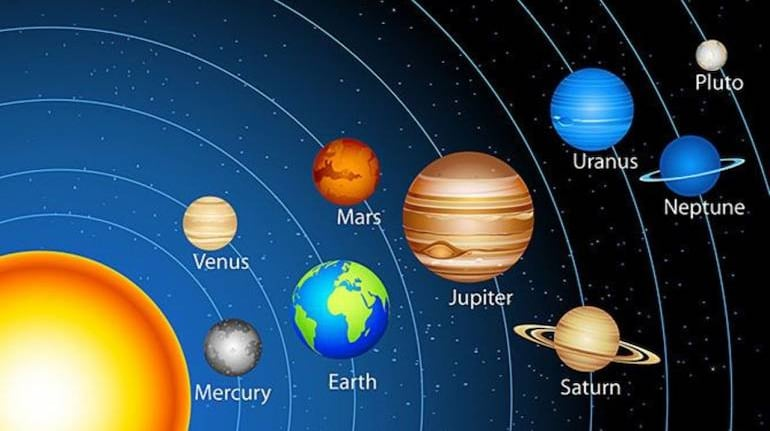Science & Technology
Wright Mons Mountain: Pluto
- 31 Mar 2022
- 8 min read
For Prelims: Pluto, Wright Mons Mountain, NASA, Icy lava, Dwarf planet, International Astronomical Union, Mauna Loa, Cryovolcanism.
For Mains: Space Technology, Pluto, Findings of New Horizons probe.
Why in News?
Recently, new findings about Pluto have been reported by the National Aeronautics and Space Administration’s (NASA) New Horizons probe.
- The probe reported that icy lava flows have recently (no more than a billion years ago) covered substantial tracts of its surface.
- The findings drew particular attention to a mountainous feature named Wright Mons.
- The only spacecraft to visit Pluto is NASA’s New Horizons, which passed close by in July 2015.
What is Wright Mons?
- A mountainous feature named Wright Mons was found on Pluto, which rises 4-5km above its surroundings. It is about 150km across its base and has a central depression (a hole) 40-50km wide, with a floor at least as low as the surrounding terrain.
- Wright Mons, was informally named by the New Horizons team in honour of the Wright brothers.
- Scientists claim that Wright Mons is a volcano, and cite the lack of impact craters as evidence that it is not likely to be older than 1-2 billion years.
- An impact crater is formed when an object like an asteroid or meteorite crashes into the surface of a larger solid object like a planet or a moon.
- Its volume exceeds 20 thousand cubic kilometres. Although considerably less than the volume of Mars’s biggest volcanoes, this is similar to the total volume of Hawaii’s Mauna Loa, and much greater than the volume of its above sea-level portion.
- The slopes of Wright Mons and much of its surroundings are seen to be crowded with hummocks up to 1km high and mostly 6-12km across.
- Scientists conclude that these hummocks are made primarily of water-ice, rather than nitrogen- or methane-ice that covers some other young regions on Pluto.
- They argue that this is consistent with the material strength necessary to form and preserve these domes, but they do recognise small patches of much weaker nitrogen-ice, mainly in the central depression.
- The hummocks were likely created by some sort of ice volcanism, known by the technical term “cryovolcanism” – erupting icy water rather than molten rock.
- Pluto’s bulk density shows that it must have rock in its interior, but its outer regions are a mixture of ices (water, methane, nitrogen and probably ammonia and carbon monoxide, too, all of which are less than a third as dense as rock) in the same way that the crust of the Earth and other rocky planets is a mixture of several silicate minerals.
- Many other areas of Pluto have been around long enough to accumulate large numbers of impact craters – no recent icy lava flows have covered them.
What are some Key Facts about Pluto?
- Pluto was categorised as a dwarf planet. In 2006, Pluto was categorised with three other objects in the solar system that are about the same small size as Pluto: Ceres, Makemake and Eris.

- Pluto was embraced as the solar system’s ninth planet upon discovery by Clyde Tombaugh in 1930.
- The crucial part of the definition of planet adopted by the International Astronomical Union (IAU) in 2006 is that a planet should have “cleared the neighbourhood of its own orbit”.
- Pluto clearly does not comply with this definition – it has rivals of comparable mass in addition to being overshadowed by the vastly more massive Neptune.
- These objects, along with Pluto, are much smaller than the "other" planets.
- Pluto – which is smaller than Earth’s Moon – has a heart-shaped glacier that’s the size of Texas and Oklahoma. It has blue skies, spinning moons, mountains as high as the Rockies, and it snows – but the snow is red.
- Pluto is about 1,400 miles wide. That's about half the width of the United States, or 2/3 the width of Earth's moon.
- Pluto orbits the Sun about 3.6 billion miles away on average, about 40 times as far as Earth, in a region called the Kuiper Belt.
- A year on Pluto is 248 Earth years. A day on Pluto lasts 153 hours, or about 6 Earth days.
- Pluto has a thin atmosphere of nitrogen, methane and carbon monoxide. The atmosphere has a blue tint and distinct layers of haze.
- Pluto has 5 moons. The largest, Charon, is so big that Pluto and Charon orbit each other like a double planet.
- Pluto’s surface is far too cold, -228 to -2380C, to sustain life as we know it.
UPSC Civil Services Examination, Previous Year Questions (PYQs)
Q. Which one of the following planets has largest number of natural satellites or moons? (2009)
(a) Jupiter
(b) Mars
(c) Saturn
(d) Venus
Ans: (a)
Exp:
- Jupiter has 79 moons which include Ganymede, the biggest moon in our solar system.
- Mars has two moons – Phobos and Deimos.
- Saturn has 82 moons, which makes it the planet with the largest number of moons.
- Note: However, when the question was asked Jupiter had the largest number of moons.
Q. Which one of the following is a spacecraft? (2008)
(a) Apophis
(b) Cassini
(c) Spitzer
(d) TechSar
Ans: (b)
Exp:
- The Cassini-Huygens space research mission commonly called Cassini, involved a collaboration among NASA, the European Space Agency (ESA), and the Italian Space Agency (ASI) to send a probe to study the planet Saturn and its system, including its rings and natural satellites.






